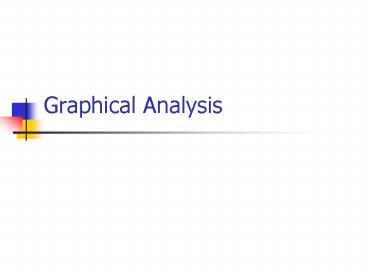Graphical Analysis PowerPoint PPT Presentation
1 / 34
Title: Graphical Analysis
1
Graphical Analysis
2
Why Graph Data?
- Graphical methods
- Require very little training
- Easy to use
- Massive amounts of data can be presented more
readily - Can provide an understanding of the distribution
of the data - May be easier to interpret for individuals with
less mathematical background than engineers
3
Graphical methods
- Quantitative data (numerical data)
- Cost of a computer (continuous)
- Number of production defects (discrete)
- Weight of a person (continuous)
- Parts produced this month (discrete)
- Temperature of etch bath (continuous)
- Graphical tools
- Line charts
- Histograms
- Scatter charts
4
Graphical methods
- Qualitative data (categorical and attribute)
- Type of equipment (Manual, automated,
semi-automated) - Operator (Tom, Nina, Jose)
- Graphical tools
- Bar charts
- Pie charts
- Pareto charts
5
Getting Started
- Classify data
- Quantitative vs. Qualitative
- Continuous or discrete (quantitative)
- Chose the right graphical tool
- Chose axes and scales to provide best view of
data - Label graphs to eliminate ambiguity
6
Graphical Analysis
- Examples
7
Bar or Column Graph
- Displays frequency of observations that fall into
nominal categories
8
Line Chart
- Shows trends in data at equal intervals
9
Graphical methods
- Acceptable graph
10
Graphical methods
- Better graph
11
Graphical Analysis Details
- Always label axis with titles and units
- Always use chart titles
- Use scales that are appropriate to the range of
data being plotted - Use legends only when they add value
- Use both points and lines on line graphs only if
it is appropriate dont use if the data is
discrete
12
Histograms
- Histograms are pictorial representations of the
distribution of a measured quantity or of counted
items. It is a quick tool to use to display the
average and the amount of variation present.
13
Histogram example
14
The Pareto principle
- Dr. Joseph Juran (of total quality management
fame) formulated the Pareto Principle after
expanding on the work of Wilfredo Pareto, a
nineteenth century economist and sociologist. The
Pareto Principle states that a small number of
causes is responsible for a large percentage of
the effect--usually a 20-percent to 80-percent
ratio.
15
Pareto example
16
Histogram Example in Excel
17
ENGR 112
- Fitting Equations to Data
18
Introduction
- Engineers frequently collect paired data in order
to understand - Characteristics of an object
- Behavior of a system
- Relationships between paired data is often
developed graphically - Mathematical relationships between paired data
can provide additional insight
19
Regression Analysis
- Regression analysis is a mathematical analysis
technique used to determine something about the
relationship between random variables.
20
Regression Analysis Goal
- To develop a statistical model that can be used
to predict the value of a variable based on the
value of another
21
Regression Analysis
- Regression models are used primarily for the
purpose of prediction - Regression models typically involve
- A dependent or response variable
- Represented as ? y
- One or more independent or explanatory variables
- Represented as ? x1, x2, ,xn
22
Regression Analysis
- Our focus?
- Models with only one explanatory variable
- These models are called simple linear regression
models
23
Regression Analysis
- A scatter diagram is used to plot an independent
variable vs. a dependent variable
24
Regression Analysis
- Remember!!
- Relationships between variables can take many
forms - Selection of the proper mathematical model is
influenced by the distribution of the X and Y
values on the scatter diagram
25
Regression Analysis
26
Regression Analysis Model
- SIMPLE LINEAR REGRESSION MODEL
- However, both b0 and b1 are population parameters
- ei ? Represents the random error in Y for each
observation i that occurs
Yi b0 b1Xi ei
27
Regression Analysis Model
- Since we will be working with samples, the
previous model becomes - Where
- b0 Y intercept (estimate of b0)
- Value of Y when X 0
- b1 Slope (estimate of b1)
- Expected change in Y per unit change in X
- Yi Predicted (estimated) value of Y
Yi b0 b1Xi
28
Regression Analysis Model
- What happened with the error term?
- Unfortunately, it is not gone. We still have
errors in the estimated values
29
Regression Analysis
- Find the straight line
- That BEST fits the data
30
Regression Analysis
- Positive Straight-Line Relationship
Yi b0 b1Xi
Y
b1
e4
e2
b0
e5
e3
e1
0
X
0
31
Least Squares Method
- Mathematical technique that determines the values
of b0 and b1 - It does so by minimizing the following expression
32
Least Squares Method
- Resulting equations
- Equations (1) and (2) are called the normal
equations
(1)
(2)
33
Least Squares Method
- Assume the following values
- Resulting equations
34
Assessing Fit
- How do we know how good a regression model is?
- Sum of squares of errors (SSE)
- Good if we have additional models to compare
against - Coefficient of determination ? r2
- A value close to 1 suggests a good fit
Where do we get these values?

